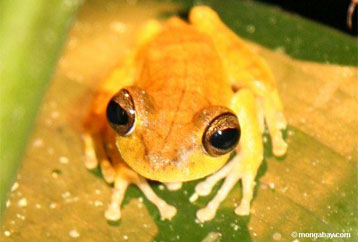Hotspot conservation may not save endangered species
Hotspot conservation may not save endangered species
mongabay.com
November 1, 2006
New research suggests conservation efforts based on biological hotspots might need to be re-prioritized since threatened species across different groups of animals — mammals, birds and amphibians — don’t necessarily occur in the same areas.
The study, published in the current edition (Nov. 2) of the journal Nature, shows a geographical discrepancy in hotspots of endangered species from different groups: geographical areas with a high concentration of endangered species from one group, do not necessarily have high numbers from other groups.
“For the first time ever this global mapping has divided the planet up into small grid squares to obtain a really detailed picture of biodiversity,” said Dr. Ian Owens, a professor from Imperial College London’s Division of Biology. “By looking at the numbers of endangered mammals, birds and amphibians in these squares, we have been able to see how this real picture varies from assumptions that have previously been made about global biodiversity of endangered species.”
 Tree frog in the Amazon rainforest Frogs are disappearing worldwide due to an outbreak of a deadly fungal disease linked to global warming. |
Owens says that different factors are responsible for extinction risk across different groups. For example, mammals might be threatened in one area by poachers, while bird and amphibian populations are stable. In another ecosystem amphibians may be dying from chytrid fungal infections while birds and mammals thrive.
“It’s really important not to assume that there are simply a number of hotspots across the globe where everything living there is endangered — the picture is far more complicated, with mammal, bird and amphibian numbers being threatened by different things, in different locations,” explained Owens.
Conservation implications
The new research suggests governments and NGOs may need to reconsider their conservation planning since “basing conservation decisions on just one type of animal can be very misleading.” For example, creating a protected area solely on the basis of an area’s high concentration of endangered birds might not mean that large numbers of endangered mammal and amphibian species will also be protected.
The paper, “The global distribution and conservation of rare and threatened vertebrates,”, appears in the November 2, 2006 issue of Nature and includes maps showing distributions of endangered animal groups.
RELATED
Future biodiversity extinction hotspots identified
Scientists have identified 20 potential extinction hotspots where hunting and human-caused habitat destruction are set to suffer significant declines in animal populations in coming years. In developing their map of future extinction hotspots, the researchers analyzed current and predicted IUCN Red List data on the extinction risk to almost 4,000 species of land mammals. Their roster includes areas not typically found on lists of the world’s most imperiled habitats, including Greenland, the Patagonian coast of South America, and Siberian tundra.
Andes of South America are world’s biodiversity champion says news study
Currently there are three “competitive” maps of the world’s biodiversity hotspots based on different criteria: areas rich in species diversity in general; threatened species specifically; and endemic species, which have a limited habitat. A new study, based on bird distribution and detailed below, found that these three maps share only 2.5% of their total area, thus adding confusion to what hotspots should be priorities for conservation efforts. The overlap all occurs in the Andean region of South America, implying that this area is the world’s biodiversity champion when it comes to birds. South America is home to more than 3400 of the world’s 10,000 bird species.
This article includes quotes from an Imperial College London news release.














